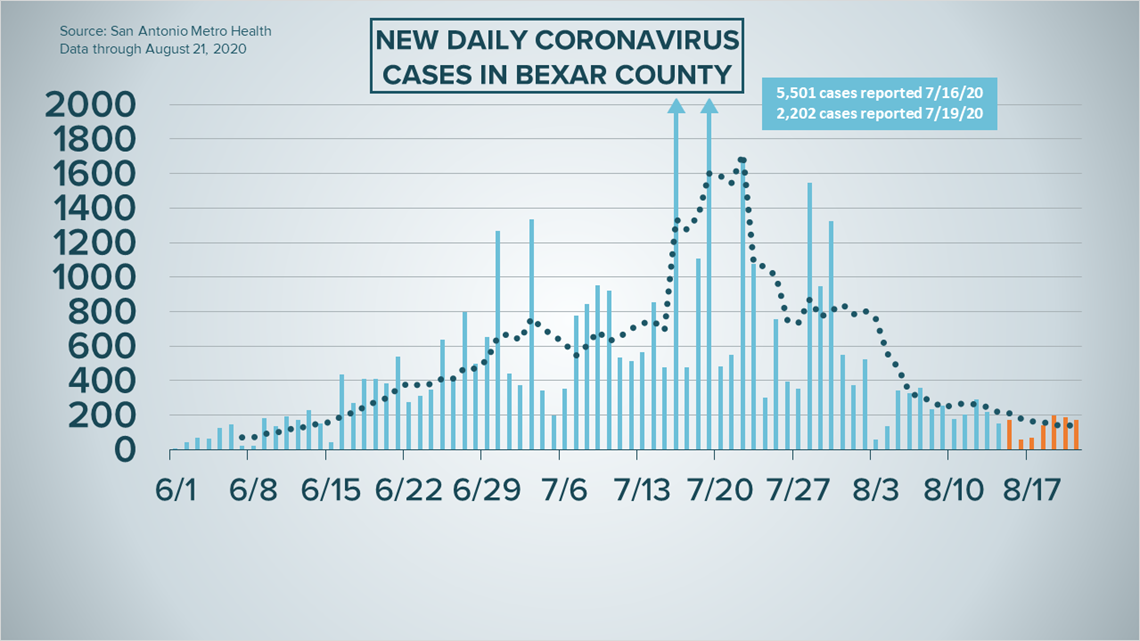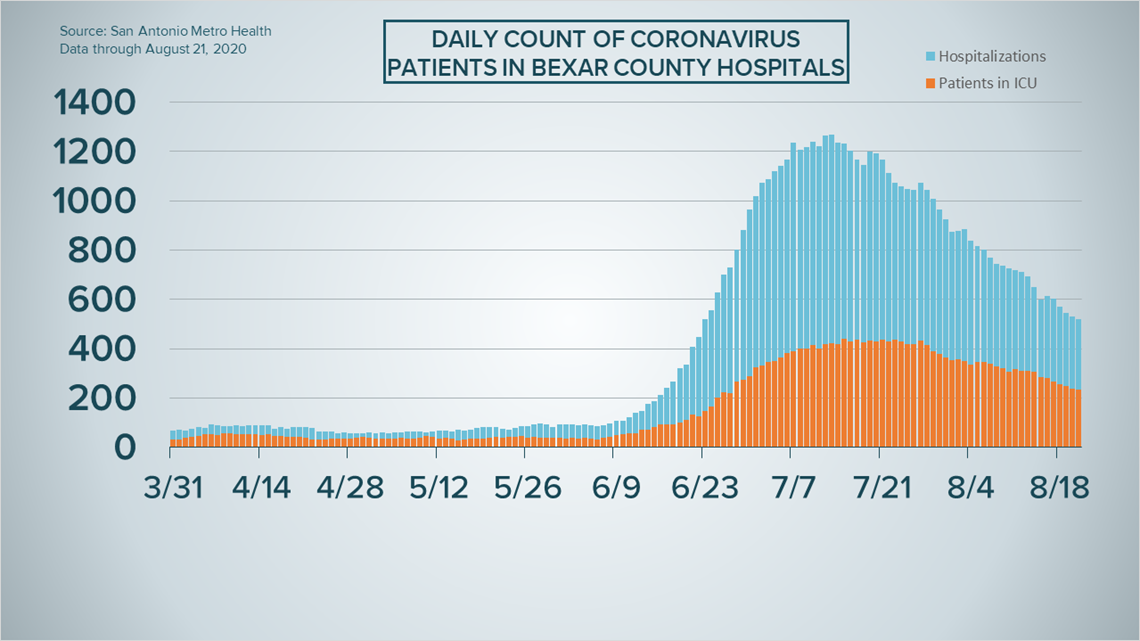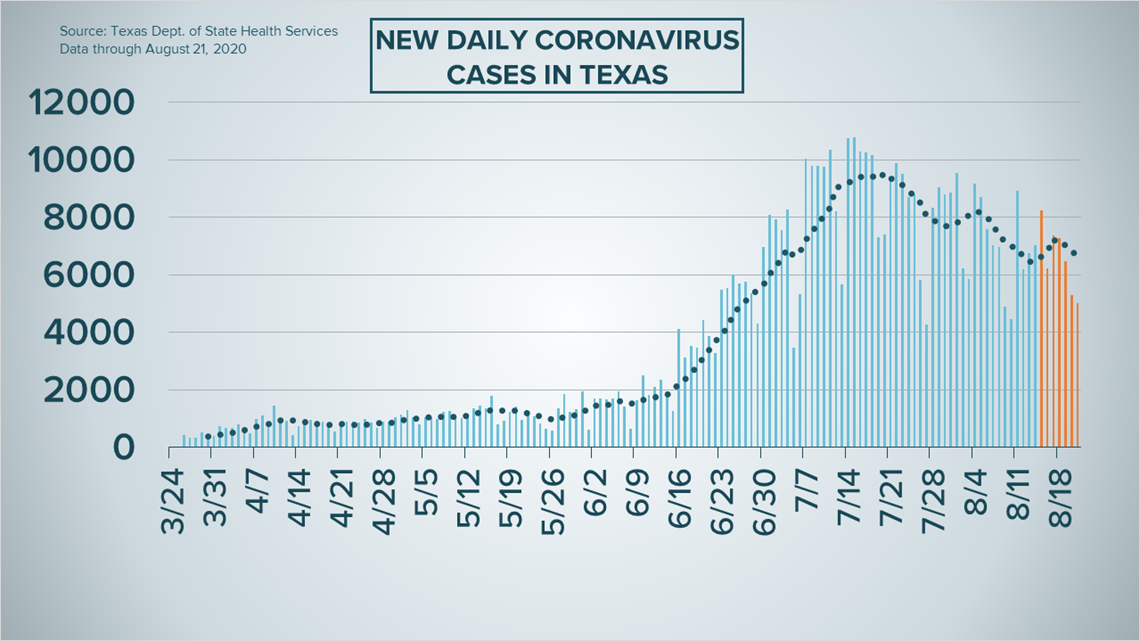SAN ANTONIO — We're tracking the latest numbers from the coronavirus pandemic in San Antonio and across Texas. Here are the latest numbers reported by Bexar and surrounding counties:
- Bexar County: 173 new cases were reported Friday, bringing the total number for the county to 44,814. The county death toll, meanwhile, rose to 698 after 21 additional fatalities were reported.
- Comal County: The county reported just nine new cases but two additional deaths Friday. There have been a total of 2,857 cases of COVID-19 in the county – including 2,270 confirmed cases – while 80 county residents have died. County officials say there are 514 active coronavirus cases, and 2,263 residents are considered recovered.
- Hays County: Officials in Hays County on Friday reported 20 new cases and no additional deaths in the county. As of Friday evening, there were a total of 5,250 lab-confirmed cases in the county (2,425 of which are active) while the death toll stayed put at 45.
How Bexar County is trending
We've tracked how many coronavirus cases have been confirmed in Bexar County from the time officials began reporting cases in March 2020. The graphic below shows the number of cases since June and charts those daily case numbers along a 7-day moving average to provide a more accurate picture of the overall coronavirus case curve in our area and the direction we're trending amid the pandemic.
On Friday, Mayor Ron Nirenberg reported another marginal count of new coronavirus cases in Bexar County, with 173. That brings the total for the county to 44,814 since the pandemic began.
Meanwhile, the mayor also reported an additional 21 deaths confirmed to have coronavirus connections. Those deaths are spread out over a period of weeks from July 22 up to Thursday. In all, 698 Bexar County residents have lost their lives to the virus.


The number of county residents receiving treatment at hospitals for COVID-19 symptoms went down once again on Friday, with 520 hospitalizations. The number of patients using ventilators (153) and in intensive care (232) also dropped from Thursday's figures.


At Friday's coronavirus briefing, Jennifer Herriott, the deputy director of Metro Health's Community Health Division, emphasized that there is no room for complacency despite the positive hospitalizations trends of recent weeks.
"We cannot take our foot off the gas pedal," she said. "Any time our numbers start to go down, I think people start to feel a little bit more comfortable, and we just can't do that. We've got to have people continuing to stay home. We've got to pay attention to the social distancing."
County Judge Nelson Wolff also made a point to warn residents not to get comfortable, pointing out that the current number of hospitalizations nearly mirrors the figure from June 23, when 520 county residents were being treated. Fewer than 10 days later, he pointed out, that number had spiked to over 1,000, and the following weeks were spent reining in the outbreak.
"This shows you how quickly the disease spreads and how long it takes to get it under control," Wolff added.
Coronavirus in Texas
The Texas Department of State Health Services on Friday reported an additional 5,021 cases of the novel coronavirus across the state, 370 of which came from a backlog of tests conducted in recent weeks. As of Friday, at least 567,580 Texans have been infected with COVID-19.
Meanwhile, the state reported an additional 258 coronavirus-related deaths, bringing the total to 11,051.


Hospitalizations continue to go down for the Lone Star State when it comes to COVID-19. On Friday, the number of Texans getting treatment for symptoms was down to 5,566.
As the school year begins to get underway for local districts, we are also keeping track of the most important updates for each, including links to dashboards created to track coronavirus cases.
Latest Coronavirus Headlines
- TABC suspends San Antonio bar's liquor license for a month after complaints of large crowds
- Here is what you need to know about the extra $300 in unemployment benefits
- San Antonio doctor opens South Texas' first coronavirus recovery clinic
- Texas will start posting coronavirus case data from public schools, education commissioner says
- Texas begins publishing some data on coronavirus cases at child care centers
- Are asymptomatic people spreading COVID-19 where you work? There's a test for that.
- CDC study suggests inmates should have been tested in mass for COVID-19
- HHS denies report COVID-19 hospital data going back to CDC
- 65% of Bexar Co. COVID-19 victims had at least one other underlying health issue, Nirenberg says
- Bexar County to close all parks over Labor Day Weekend
- Airbnb bans house parties worldwide, citing coronavirus mandates
Coronavirus symptoms
The symptoms of coronavirus can be similar to the flu or a bad cold. Symptoms include fever or chills, cough, shortness of breath or difficulty breathing, fatigue, muscle or body aches, headache, new loss of taste or smell sore throat, congestion or runny nose, nausea or vomiting and diarrhea, according to the Centers for Disease Control.
Most healthy people will have mild symptoms. A study of more than 72,000 patients by the Centers for Disease Control in China showed 80 percent of the cases there were mild.
But infections can cause pneumonia, severe acute respiratory syndrome, kidney failure, and even death, according to the World Health Organization. Older people with underlying health conditions are most at risk.
On June 25, the CDC expanded the list of groups at a higher risk of severe illness due to coronavirus.
Experts determined there was consistent evidence these conditions increase a person's risk, regardless of age:
- Chronic kidney disease
- COPD (chronic obstructive pulmonary disease)
- Obesity (BMI of 30 or higher)
- Immunocompromised state (weakened immune system) from solid organ transplant
- Serious heart conditions, such as heart failure, coronary artery disease, or cardiomyopathies
- Sickle cell disease
- Type 2 diabetes
The CDC believes symptoms may appear anywhere from two to 14 days after being exposed.
Human coronaviruses are usually spread...
- Between people who are in close contact with one another (within about 6 feet).
- Through respiratory droplets produced when an infected person coughs, sneezes or talks. These droplets can land in the mouths or noses of people who are nearby or possibly be inhaled into the lungs.
- Some recent studies have suggested that COVID-19 may be spread by people who are not showing symptoms.
Help stop the spread of coronavirus
- Stay home when you are sick.
- Eat and sleep separately from your family members
- Use different utensils and dishes
- Cover your cough or sneeze with your arm, not your hand.
- If you use a tissue, throw it in the trash.

